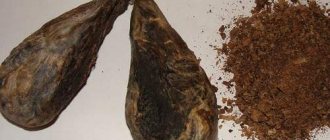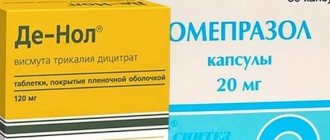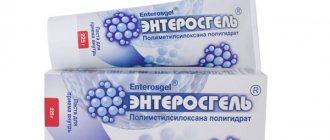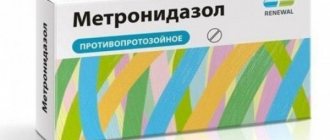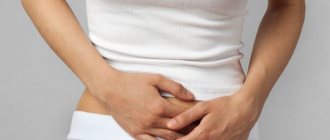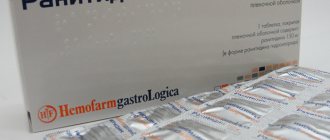Diseases of the digestive tract often bother adults. Inflammatory processes of the stomach occupy leading positions in the structure of organ pathology. The main task of a specialist is timely treatment and prevention of exacerbations. The course of therapy includes the use of bismuth preparations.
De-Nol for gastritis is included in the eradication scheme for Helicobacter pylori, which in most cases is the cause of inflammation. It is important to follow the instructions and take the medicine correctly.
Composition and release form
On the pharmacological market, the drug is released in oral form. In pharmacy chains, De-nol is presented in tablets of 56 and 112 pieces. This amount is sufficient to eliminate the symptoms of the disease and continue maintenance therapy.
Each unit in a blister is biconvex cream-colored with characteristic marks on both sides and the abbreviation of the manufacturer.
The medicine contains the active substance and auxiliary elements. The main component is colloidal bismuth subcitrate in an amount of 120 mg. The chemical compound reacts with protein structures, which, in the presence of hydrochloric acid, form chelate compounds. They concentrate in pathologically changed areas and promote epithelial regeneration.
The form is supplemented with several components. They are represented by the following adjuvants:
- corn starch;
- potassium polacriline;
- povidone;
- magnesium stearate;
- hypromellose;
- macrogol 6000.
How to take together
The peculiarity of taking De-Nol is that you need to drink it on an empty stomach. The more acid-containing liquid, the more active the chemical reaction will take place, the bismuth salts will settle, forming a thin protective film that will protect the stomach from an aggressive environment.
Usually De-Nol is taken 30 minutes before breakfast, lunch or dinner. You need to drink a small amount of water. After eating, you can take a dose of antibiotic. Taking antibiotics and De-Nol together in one regimen increases the chances of getting rid of Helicobacter pylori forever.
Indications
The drug has a pronounced effect due to the medicinal properties of the main substance. De-nol has the following effects:
- anti-inflammatory;
- regenerating;
- bactericidal;
- gastrocytoprotective;
- astringent;
- enveloping.
Coating preparations for the stomach and intestines
The use of medications based on bismuth subcitrate is a mandatory direction in the fight against gastrointestinal pathology. When using the drug De-nol, the treatment of gastritis is more effective.
According to the instructions, the oral form is prescribed for the following pathological processes:
- Gastric and duodenal ulcers during exacerbation of the process.
- In case of diffuse inflammatory changes in the stomach with high acidity.
- For atrophic gastritis with low acidity.
- Chronic gastroduodenitis.
- Gastroesophageal and duodenogastric reflux.
- In the eradication scheme of Helicobacter pylori infection.
- Functional dyspepsia, which is not associated with organic damage to the digestive organs.
- Erosive and ulcerative defects of the epithelium of the intestines and stomach, including those caused by long-term use of non-hormonal drugs with anti-inflammatory effects and other medications.
- For the treatment of irritable bowel syndrome with symptoms of diarrhea.
More information about the drug "De-nol"
“De-nol” is used for diagnosing chronic gastritis or gastric ulcers in the acute stage, for irritable bowel syndrome, prolonged diarrhea, dyspeptic disorders of various origins, for the prevention of gastrointestinal diseases.
The prescription of “De-nol” is made exclusively by a doctor, since the drug cannot be used for all types of gastritis, for example, the medicine is not prescribed for acute gastritis.
The drug "De-nol" is available in the form of film-coated tablets. The active ingredient in De-nol is bismuth tripotassium dicitrate. De-nol has a strong enveloping, anti-inflammatory, astringent, and antiseptic effect.
The high effectiveness of the drug lies in its ability to accelerate the recovery process. When using De-nol, the mucous membrane is quickly restored, and damaged areas acquire an almost original appearance.
What does the medicine affect? When taking the drug, many processes occur:
- compaction of the top layer of areas damaged by erosion;
- activation of the regeneration process;
- protection of the walls of the digestive tract from the negative influence of an aggressive environment (acid, bile, enzymes);
- reducing the acidity of gastric juice and regulating the production of hydrochloric acid;
- reduction of pain and inflammatory reaction in the damaged area;
- elimination of dyspeptic symptoms: heartburn, nausea and belching;
- reducing the number of relapses and exacerbations.
How does the mechanism of action occur? When the tablet enters the stomach, it begins to act - it reacts with gastric juice, and the process of precipitation of insoluble bismuth salts occurs, which interact with proteins and form foamy compounds on the surface layer of the organ mucosa.
A protective whitish film forms on damaged areas of the mucosa, which remains for several hours. This process prevents the negative effects of aggressive biological substances - hydrochloric acid, bile, enzymes - on the intestinal and gastric mucosa with increased acidity.
The drug stimulates the production of prostaglandids, which promotes the growth of the synthesis of mucin (mucus) and other compounds that improve the properties of gastric secretions. In places of erosion, restoration processes are stimulated. “De-nol” is resistant to the influence of hydrochloric acid, which means it reliably protects the body and does not require additional exposure.
In addition, the medicine has a very important property: antibacterial, which is very important provided that the causative agent of the disease is the bacterium Helicobacter pylori.
Use of De-nol for gastritis
Bismuth subcitrate, entering the lumen of the gastrointestinal tract, almost does not penetrate into the systemic circulation. The active substance forms a special film on the surface. A small part of the drug is eliminated through the kidneys, the rest is excreted in the feces. The application regimen specified in the De-nol instructions allows you to achieve the required concentration of the main component to achieve the following results:
- Creating a protective barrier against the aggressive effects of hydrochloric acid in gastritis with high acidity.
- Increasing the regenerative capacity of the epithelium in atrophic conditions and gastritis with low acidity.
- Acceleration of healing of superficial and deep ulcerative defects with the formation of scar tissue in erosive gastritis.
- Restoring motility of the digestive tract, which reduces the likelihood of reflux gastritis.
- Stimulation of factors aimed at the production of mucus, alkaline components, components of epidermal growth in the area of inflammation. This is especially important in the case of catarrhal, hypertrophic gastritis.
- Antimicrobial effect against Helicobacter pylori.
Important! The method of application and duration of taking the drug depend on the severity of the process, the type of pathology and the presence of concomitant diseases.
When using the drug, there is a risk of side effects. Undesirable clinical consequences of administration are represented by the following symptoms:
- dyspeptic symptoms - nausea, vomiting, unstable stools, sometimes stomach pain;
- allergic manifestations - rash, itching, in severe cases - anaphylactic shock;
- a change in the color of stool, even black, due to the formation of bismuth sulfide.
Bismuth subcitrate is contraindicated in case of renal failure and a history of allergic reactions to the components of the drug. The drug is not recommended for pregnant and lactating women, given the lack of reliable information on use in this category of patients.
Features of application
The dosage of the drug depends on how the disease progresses, as well as on the age and individual characteristics of the patient.
Typically the drug is prescribed as follows:
- adults and adolescents over 14 years of age – 4 tablets during the day;
- children 8-14 years old – 1 tablet twice a day;
- children 4-8 years old - 8 mg per kg of body weight per day, divided into two doses.
Take half an hour before eating. The medicine must be swallowed with cold, still water. Not all pediatricians consider it acceptable to prescribe the drug to preschool-age patients.
According to observations, the patient’s condition begins to improve significantly only after 2 weeks of taking the drug. In this case, the patient should give up bad habits that delay recovery during treatment. A mandatory element of treatment should be a dietary diet that excludes the intake of foods and drinks that can irritate the damaged mucous membrane.
Taking the drug should not be combined with the consumption of dairy products. They should not be eaten for at least 8 hours after using the medicine, much less taken with milk. This can significantly reduce the effectiveness of treatment and cause diarrhea, constipation, flatulence or IBS (irritable bowel syndrome).
How to take De-nol correctly for gastritis
The drug is prescribed for various forms of inflammation of the stomach during exacerbation and for prevention according to the scheme presented in the table.
| Pathology | Instructions |
| Gastritis with high acidity | 1 tablet up to 4 times daily or 2 tablets 2 times daily for 4 to 8 weeks |
| Gastritis with low acidity | |
| Atrophic process | |
| Hypertrophic process | |
| Erosive process | 1 tablet 4 times a day 6-8 weeks |
| Gastritis associated with Helicobacter pylori | 1 tablet 2 times a day along with antibacterial drugs and proton pump inhibitors for 7-14 days |
Attention! After completing the course, you should take a break of up to 2 months. This is due to the possible accumulation of bismuth and the risk of encephalopathy.
Effect of the drug
The drug can be taken to prevent seasonal exacerbations of the disease. It quickly dissolves in the gastrointestinal tract and penetrates into the deeper layers of the mucous membrane, preventing bacteria from multiplying.
Pharmacological treatment of ulcers with Denol has several goals:
- inhibits pathogenic bacterial flora;
- creates a protective film that envelops the walls of the stomach;
- reduces the acidity of gastric juice, normalizes the synthesis of pepsin.
The complex of these measures helps to create conditions under which the gastric mucosa recovers more quickly. The medicine is often prescribed in combination with antibacterial drugs. This makes it possible to exert a powerful therapeutic effect on damaged areas of the mucosa.
Moreover, even long-term therapy with the drug does not cause resistance of pathogenic microflora, which was recorded through clinical studies. Bismuth subcitrate is able to accumulate in the cellular structure of bacteria and destroy it from the inside.
How to drink De-nol for gastritis: before or after meals
To get a positive result, follow the recommendations for using the medicine. It is necessary to drink De-nol correctly for gastritis with high acidity and low acidity, as well as other disorders of the gastrointestinal tract. Take the tablets half an hour before meals at regular intervals. The last dose is before bedtime. Do not consume the substance simultaneously with milk or juice, only with a small amount of water. Any liquid other than water interferes with the therapeutic effect of the drug.
Carefully! During therapy, the use of other products containing bismuth is not allowed.
How much to drink De-nol for gastritis
The treatment regimen and course duration are prescribed by a gastroenterologist. In each specific case, the specialist determines individually how much De-nol to take for gastritis or other pathologies. The duration of the course ranges from 4 to 8 weeks. To eliminate Helicobacter pylori infection, bismuth subcitrate should be taken for 7-14 days, and then continued after eradication for up to 6 weeks inclusive as maintenance therapy.
For children
The drug is prescribed not only to adults. Doctors successfully use De-nol for children with gastritis and functional disorders of the digestive system. The treatment regimen has features in different age groups.
| Age | Admission rules |
| From four to eight years | Based on 8 mg per kg per day. The quantity is divided into two doses. However, no more than two tablets per day. |
| From eight to fourteen years | 1 tablet 2 times a day with a break of 12 hours |
| Over fourteen years of age | The quantity and frequency of the drug is the same as for older people - 1 tablet 4 times a day or 2 tablets 2 times a day |
Indications for use
Gastroenterologists prescribe De-Nol for various pathologies of the stomach and duodenum, accompanied by damage to the internal mucous membrane of the organs. The list of indications includes:
- , including peptic and caused by pylori
; - chronic gastritis and gastroduodenitis in the acute phase, including those associated with pylori
; - functional intestinal disorders (IBS), occurring with stool disorders in the form of diarrhea;
- functional dyspepsia;
- damage to the gastric mucosa due to long-term therapy with non-steroidal anti-inflammatory drugs.
De-nol for the prevention of gastritis
Prevention of the disease is a prerequisite for a positive result of therapy. Gastroenterologists recommend taking De-nol for the prevention of gastritis as an alternative if drugs that normalize the secretion of hydrochloric acid are insufficiently effective. The drug can also be combined with H2-histamine blockers and proton pump inhibitors.
Bismuth subcitrate is prescribed as planned 2 times a year in the fall and spring, taking into account the high risk of relapse during the off-season. In the absence of symptoms of the disease, the duration of therapy ranges from 10 to 14 days. If there is an exacerbation of pathology, additional diagnostics are carried out. Identification of Helicobacter pylori is an indication for an eradication course, which includes a combination of De-nol with antibiotics and medications that regulate gastric acidity. After this, the maintenance preventive course is continued for up to 6-8 weeks.
Combination with other drugs
De-Nol should be taken in combination with proton pump inhibitors, which reduce the secretion of hydrochloric acid. One of the most commonly prescribed antisecretory drugs is Omeprazole (commercial name Omez). Acting in combination, these two drugs can enhance the therapeutic effect of antibacterial drugs.
The treatment regimen is prescribed by a specialist gastroenterologist, while Omez is taken once a day, since it has a prolonged effect. This remedy is necessary for any level of acidity, changing only its dosage. The use of Omez together with De-Nol is necessary in the course of treatment of stomach ulcers to protect the mucous membrane from the irritating effects of acid.
You should know that Omez is a prescription drug, so it is not recommended to use it without a prescription from a specialist. Uncontrolled use of the drug can hide an oncological tumor, one of the characteristic symptoms of which is increased acidity. Therefore, taking any medications requires a preliminary consultation and examination.
After determining the presence of Helicobacter pylori, antibacterial drugs are additionally prescribed for a course of at least 7 days. For stomach ulcers, antibiotics such as:
- Clarithromycin or Sumamed;
- Amoxicillin or Hincocil;
- Levofloxacin;
- Metronidazole or Tinidazole.
The last two drugs are classified as antiprotozoal drugs. These antibiotics of synthetic origin are used as blockers of tissue respiration of pathogenic microorganisms. To restore the microflora disturbed due to antibiotics, probiotics are used (Acipol, Linex, Bifiform and others).
Treatment of gastritis with De-nol with other drugs
Therapy for gastritis involves the use of several medications. The mechanism of action of bismuth subcitrate is determined by the reaction of the active substance and hydrochloric acid with the formation of a protective film. Therefore, the peculiarities of drug interactions should be taken into account.
- Between taking antacids, such as Phosphalugel, Almagel, and De-nol, a break of at least 30 minutes should be observed.
- A time interval is necessary when carrying out eradication therapy with antibiotics. This is due to a decrease in the concentration of tetracycline in the blood during treatment with bismuth.
- Proton pump inhibitors - Omeprazole, Omez, Ultop - do not interact with the substance. Therefore, medications can be taken at the same time.
- Bifiform is drunk regardless of food. The bacterial drug improves the effectiveness of eradication therapy. Combination with De-nol is allowed, but it is not used together with antibiotics; you need to take the drug after completing the course of antibacterial therapy.
- There is no interaction of bismuth with gastrointestinal motility regulators - Motilium, Trimedat. You can take De-nol at the same time as this group of drugs.
Interaction with other drugs
When taking De-Nol, it is important to consider its compatibility with other drugs and food, as they may affect the therapeutic effectiveness of the drug.
For at least 30 minutes before and after taking the drug, it is not recommended to ingest other medications, as well as take food or liquid. This is especially true for antacid medications, dairy products, fruits and juices made from them. This is due to the fact that the gastric juice present in the stomach is necessary for the formation of a protective layer under the influence of De-Nol.
When taken together with tetracyclines, the degree of absorption of antibacterial agents decreases.
The pharmacological activity of De-Nol is affected by simultaneous use with other drugs
Analogs
Pharmaceutical manufacturers produce products containing bismuth under various trade names.
Pharmacies offer analogues of De-nol, which differ in form, substance content, quantity and price.
| Titles | Compound | Release form | Amount in a package | Features of application |
| Vis-nol | Bismuth subcitrate | Capsules | 30 and 100 pieces | Children from 4 years old |
| Gastro-norm | Bismuth subcitrate | Pills | 40 and 100 pieces | Children from 4 years old |
| Ulcavis | Bismuth subcitrate | Pills | 28 and 112 pieces | Children from 4 years old |
| Vikalin | Bismuth nitrate, magnesium carbonate, sodium bicarbonate, buckthorn bark, calamus rhizomes, rutin, kellin | Pills | 10 pieces | Not prescribed |
| Vikair | Bismuth nitrate, magnesium carbonate, sodium bicarbonate, buckthorn bark, calamus rhizomes | Pills | 10 pieces | Children from 7 years old |
| Ventrisol | Bismuth subcitrate | Pills | 36 pieces | Children from 4 years old |
| Novobismol | Bismuth subcitrate | Pills | 56 pieces | Children from 4 years old |
| Escape | Bismuth subcitrate | Pills | 40 pieces | Children from 4 years old |
Reviews from doctors and people who received them
Bismuth preparations have been used for many years to eliminate pathological conditions of the gastrointestinal tract. Thanks to its active properties, the medicine has established itself as an effective medicine. When treated with De-nol, reviews from people who have taken it for gastritis are mostly positive. Patients say that unpleasant symptoms go away within a few days after starting therapy. Most adults note a decrease in the number of relapses of gastritis when taking the drug systematically.
Experts observe excellent tolerability of bismuth subcitrate. Reviews from doctors indicate a low likelihood of adverse reactions and complications. This allows De-nol to be used in patients of different age groups. This is of great importance in the treatment of gastritis and other forms of pathology of the digestive system in children, given the limited use of alternative remedies. Several tablet release options allow you to prescribe a trial, economically affordable course of therapy.
An integrated approach to the treatment of gastritis with the inclusion of the drug De-nol guarantees high-quality and quick treatment results.
Answers on questions
De-Nol - an antibiotic or not?
De-Nol, or bismuth dicitrate, is part of the group of gastroprotectors and is an antiulcer agent. In addition to the astringent, enveloping effect, it also has antimicrobial properties, especially in relation to Helicobacter pylori. However, the drug is not an antibiotic and is often used only as part of complex eradication therapy.
The main effect of De-Nol is binding to proteins at the bottom of the ulcer and the formation of protective films there. Bismuth also reduces the activity of pepsin, improves microcirculation in the gastric mucosa, which has a positive effect on the regeneration process.
Can my stomach hurt from taking De-Nol?
The official instructions for the drug indicate that sometimes side effects such as vomiting and nausea occur. However, they are transient in nature, that is, they do not last long and often go away on their own. Nausea is not the equivalent of pain; it is manifested by unpleasant sensations in the epigastric region, a feeling of heaviness and the urge to vomit.
There should be no pain in the stomach area. If they appear, you should definitely consult a doctor, since most likely they are not related specifically to taking De-Nol.
It is important to know! It is prohibited to take De-Nol for more than 8 weeks in a row, or to exceed the dosage specified in the instructions.
